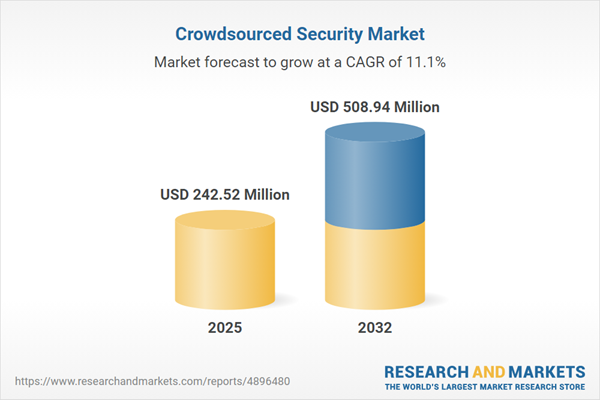Speak directly to the analyst to clarify any post sales queries you may have.
Crowdsourced security is transforming how enterprises identify and manage cyber risks by leveraging a global network of skilled researchers, supporting a proactive and adaptive approach to safeguarding digital assets.
Market Snapshot: Crowdsourced Security Market Growth and Trends
The Crowdsourced Security Market grew from USD 218.58 million in 2024 to USD 242.52 million in 2025. It is projected to advance at a CAGR of 11.14%, reaching USD 508.94 million by 2032.
Scope & Segmentation
This report delivers an in-depth assessment of the global Crowdsourced Security Market, thoroughly analyzing segment-specific dynamics across geographies, industries, and deployment models. Key areas covered include:
- Security Testing Types: Bug bounty programs, code review, mobile application pentesting, network infrastructure pentesting, penetration testing, red teaming, security audits, threat hunting, vulnerability assessment, web application pentesting
- Deployment Models: Cloud (private and public) and on premises
- Organization Sizes: Large enterprises, small enterprises, medium enterprises
- Industry Verticals: Banking, financial services, insurance, government (federal, state, and local), healthcare (hospitals, medical devices, pharmaceuticals), IT services and consulting, telecom operators, retail and e-commerce (brick and mortar and online)
- Regional Coverage: Americas (North America, Latin America), Europe, Middle East and Africa, Asia-Pacific
- Key Companies Profiled: HackerOne, Bugcrowd, Synack, Cobalt Security, YesWeHack, Intigriti, Detectify, Zerocopter, Hacken, Yogosha
Key Takeaways for Senior Decision-Makers
- Crowdsourced security delivers accelerated detection of vulnerabilities by engaging external ethical hackers and specialized researchers, increasing speed and coverage.
- Integrating this model within risk frameworks enables enterprises to address evolving threats beyond traditional internal and perimeter-based controls.
- Adoption supports ongoing business objectives by aligning security postures with digital transformation initiatives and dynamic regulatory requirements across major industries.
- Platform providers continue to innovate, introducing automation, advanced analytics, and managed services, improving program scalability and outcome measurement for enterprises of all sizes.
- Sector-specific customization ensures financial services, government, healthcare, IT, and retail can optimize security approach based on their unique regulatory and operational needs.
Crowdsourced Security Market: Tariff Impact
After the United States adjusted technology-related tariffs in 2025, enterprise strategies in cybersecurity underwent notable realignment. Budget allocations for reward programs and platforms became more scrutinized, causing interest to shift toward local partnerships and operational models that optimize cost while supporting stringent compliance requirements. This adjustment has strengthened domestic research communities and encouraged the growth of regional platforms, fostering a more resilient supply chain and workforce within the sector. Global vendors have adopted flexible pricing and localization, accommodating fiscal changes while remaining competitive.
Methodology & Data Sources
This analysis uses a blended approach, combining desk research from public and industry reports with interviews of senior security stakeholders and leading platform providers. Quantitative surveys, peer reviews, and third-party validations underpin key findings and guarantee an objective evaluation of market drivers, segment performance, and best practices.
Why This Report Matters
- Identifies actionable strategies for aligning crowdsourced security with digital business goals and compliance mandates across industry verticals and regions.
- Enables benchmarking against sector peers by providing segmentation insights and profiling the technology landscape, deployment options, and leading vendor capabilities.
- Highlights emerging operational models and regulatory trends so leaders can inform investment decisions and future-proof security programs.
Conclusion
The Crowdsourced Security Market is accelerating shifts toward collaborative, resilient cyber defense. Leaders who invest strategically in adaptive models and continuous program maturity will be positioned to better manage enterprise risk and maintain stakeholder trust in a rapidly evolving digital world.
Additional Product Information:
- Purchase of this report includes 1 year online access with quarterly updates.
- This report can be updated on request. Please contact our Customer Experience team using the Ask a Question widget on our website.
Table of Contents
3. Executive Summary
4. Market Overview
7. Cumulative Impact of Artificial Intelligence 2025
Companies Mentioned
The companies profiled in this Crowdsourced Security market report include:- HackerOne, Inc.
- Bugcrowd, Inc.
- Synack, Inc.
- Cobalt Security, Inc.
- YesWeHack SAS
- Intigriti BV
- Detectify AB
- Zerocopter NV
- Hacken OÜ
- Yogosha SAS
Table Information
| Report Attribute | Details |
|---|---|
| No. of Pages | 189 |
| Published | October 2025 |
| Forecast Period | 2025 - 2032 |
| Estimated Market Value ( USD | $ 242.52 Million |
| Forecasted Market Value ( USD | $ 508.94 Million |
| Compound Annual Growth Rate | 11.1% |
| Regions Covered | Global |
| No. of Companies Mentioned | 11 |









